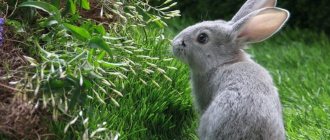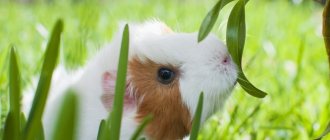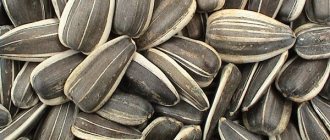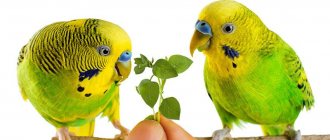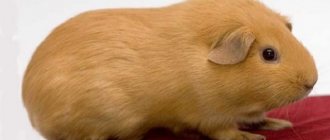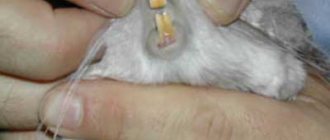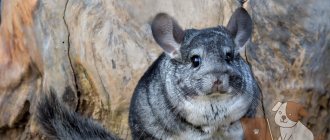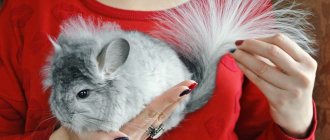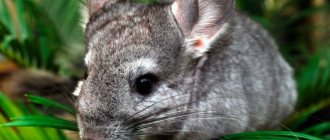The exotic rodent chinchilla is a popular pet with a pretty appearance and excellent health. With proper nutrition and care, a chinchilla can live up to 20 years. It is very important to choose the right diet for your pet. Poor-quality feeding disrupts the functioning of the reproductive and digestive systems and can cause premature death of the rodent.
In the article we will look at feeding chinchillas at home, what can and cannot be given to the animal, the features of the diet and which food is better to choose.
Rules for feeding pet chinchillas
The chinchilla is a herbivorous rodent that eats food in small quantities, but quite often.
Basic feeding rules:
- There should always be a supply of healthy food in your pet's feeder.
- New foods are introduced into the diet with caution.
- Balanced and varied menu.
- Chinchillas are very active, so they need high-calorie food, which also keeps the rodent's beautiful fur healthy.
Nutrition and daily routine
Chinchillas are nocturnal. Activity appears closer to 18-20 pm. The owner must ensure that there is enough food in the pet's feeder to eat at night.
It is better to feed the rodent at the same time. He will quickly get used to the regime, which will have a positive effect on the digestion process.
Chinchillas have sharp teeth that grow throughout their lives. In order for the pet to have the opportunity to grind down its teeth if necessary, you need to put tree branches in the cage, with the exception of coniferous species with a high resin content. Preferred are apple, linden, birch and hazel.
In addition to wooden twigs, special toys, mineral and chalk stones are also used.
Composition and balance of the diet
The diet for a pet rodent is selected individually, taking into account the pet’s age, health status, taste preferences and physiological characteristics of the body.
The main composition of the diet for pet chinchillas:
- Rough feed - hay, branches of trees and shrubs.
- Grain mixtures for chinchillas.
- Treats – berries and nuts, dried fruits, vegetables.
The daily food intake for an adult pet is 55-65 g. A balanced diet involves feeding in the following ratio: 25 g of roughage, 25 g of grain mixture, up to 5 g of vegetables and the same amount of additional treats.
How to feed
The first feeding takes place no earlier than 6 pm. The owner can pour grain feed into the feeder. It is not necessary to calculate the portion. Chinchillas are not prone to gluttony and obesity, so they will eat exactly as much as their body needs.
There should always be fresh and clean hay in the cage. The bundle can be placed in a certain corner or in a special hay feeder. Make sure your chinchilla is never left without this tasty and healthy food.
Drinking regime
Clean drinking water should always be freely available to the rodent. It is better to use distilled or filtered water. You should not give chinchillas regular tap water. You can also give chinchillas a decoction of chamomile, rose hips, and currants without adding sugar.
The benefits of herbs in the diet
In their natural habitat, chinchillas' diet consists of 90% grasses. Therefore, they must be included in the pet’s menu. In addition, plant components have several beneficial properties:
- Rich in fiber. This substance is necessary to normalize digestive processes. In particular, intestinal peristalsis, which in chinchillas is much longer than in most mammals, and is specially adapted for digesting coarse fibers.
- Contains organic acids. These compounds activate metabolism. Especially useful for adults and elderly individuals.
- Rich in vitamins necessary to strengthen the immune system and increase metabolism. The most common vitamins found in herbs are B, A, C, D, K, and P.
- Includes microelements necessary for the normal functioning of internal organs and hematopoiesis. For example, iron, iodine, magnesium, manganese, potassium, calcium.
Also, many herbs contain essential substances - compounds that have strong, persistent odors. Therefore, during a meal, a chinchilla can not only eat, but also undergo an aromatherapy procedure.
List of healthy foods for chinchillas
When creating a menu for a pet rodent, you need to take into account the body's daily need for proteins, carbohydrates and fats.
Percentage of useful components:
- Proteins – up to 20%. This component is responsible for cell regeneration and fur elasticity. Lactating and pregnant rodents need to be given protein food in increased quantities, as it is responsible for the process of formation of the young's organs and milk production.
- Carbohydrates – up to 30-35% of the daily feed. They normalize the functioning of the digestive system and promote the removal of toxins from the body.
- Fats – 4-5%. They promote proper development, improve the condition of fur, and are an important source of energy for rodents.
The chinchilla's body also needs:
- magnesium – stimulating the body’s defense reactions;
- potassium – normalizes water-salt balance;
- folic acid – improves intestinal function;
- iron – promotes proper transport of oxygen to tissues.
An exotic pet's diet should contain healthy and high-quality products.
What to feed chinchillas:
- fresh hay;
- tree branches - pear, apple, sea buckthorn, birch, willow, etc.;
- dried herbs - parsley, spinach, burdock, plantain, clover, lettuce, dandelion grass, etc.;
- tree leaves;
- grain mixtures - wheat, corn, buckwheat, oatmeal, pearl barley;
- legumes - peas, beans, beans;
- pieces of dried vegetables - carrots, zucchini, tomatoes, bell peppers;
- dried fruits - apples, pears, grapes, bananas, apricots, figs;
- dried berries - blueberries, wild strawberries, strawberries, rose hips;
- nuts - walnuts, hazelnuts, peanuts.
The diet of pregnant and lactating chinchillas must include dairy products: milk, kefir, natural yogurt, cottage cheese, yogurt.
What herbs can you give?
Quite often, chinchilla owners collect for their pets all the herbs they encounter along the way. However, this can lead to disastrous consequences. To prevent the animal from getting poisoned, much less die, you need to remember the list of herbs that you are allowed to feed chinchillas:
- chamomile – contains phytoncides that have an antibacterial effect;
- dandelion – strengthens the nervous system, has a beneficial effect on the functioning of the kidneys and hematopoietic system;
- plantain – has a regenerating, anti-inflammatory, anti-allergic, calming effect;
- burdock – has wound-healing properties, improves blood clotting, restores intestinal microflora, and has a choleretic effect;
- nettle – rich in B vitamins and minerals, has a beneficial effect on the functioning of the cardiovascular system, prevents the development of anemia;
- yarrow – normalizes stomach function, prevents the development of liver and gall bladder diseases;
- clover – has anti-inflammatory and antibacterial effects, helps with diseases of the upper respiratory tract;
- St. John's wort – accelerates tissue regeneration, improves metabolism, suppresses the vital activity of endoparasites;
- lemon balm - relieves spasms and eliminates pain, strengthens the heart muscle, has a sedative effect;
- calendula – contains substances that prevent the development of cancer, strengthens the immune system, increases the absorption of vitamins;
- spinach – increases the elasticity of blood vessels, improves the functioning of the gastrointestinal tract, contains antioxidants that prevent premature aging of the body;
- dill – contains a lot of zinc and essential oils, prevents the development of diseases of the cardiovascular system, fights bloating and flatulence;
- parsley – improves digestion processes, helps with liver diseases;
- green tea is a strong antioxidant that quickly removes waste and toxins from the body.
It is worth noting that the herbs listed should not form the basis of a fluffy’s diet. They are given to the chinchilla in addition to the main food, as treats. Some herbs need to be given with great care, such as shepherd's purse. This weed is dangerous for females during pregnancy. But at the same time, it is useful for non-pregnant chinchillas with a disease such as endometritis.
What not to give to chinchillas
Chinchillas should not be fed food from their table, as well as various foods not intended for these animals. There is also a list of products prohibited for feeding exotic rodents.
What not to give to chinchillas:
- from grain crops - rye;
- juicy herbs, vegetables and fruits, because chinchillas may have indigestion;
- leaves of lily of the valley, buttercup, milkweed, field mustard, datura, marigold, fern, poisonous buttercup, larkspur and hemlock - these herbs are poisonous;
- branches - coniferous trees, chestnut, maple, cypress, white acacia, elderberry, plum, apricot, cherry;
- from fruits - citrus fruits, persimmons;
- vegetables – potatoes and fresh cabbage;
- pine nuts and almonds;
- apricot kernels;
- offal;
- meat, bones;
- any sweets (including dried fruits), honey;
- hard cheese;
- sausage and smoked meats;
- products of non-natural origin.
Forbidden herbs
Some herbs are not only dangerous for chinchillas, but can also lead to death of the pet, and in a fairly short time. Because the owner does not always understand that something is wrong with the animal, and it is necessary to urgently take it to the veterinarian. To prevent your fluffy from getting poisoned, you need to remember the list of herbs prohibited for chinchillas:
- legume tops;
- lily of the valley;
- buttercup;
- celandine;
- hemlock;
- hogweed;
- dope;
- henbane;
- ferns;
- marigold;
- night blindness;
- spurge.
If the owner does not understand herbs, it is better not to take risks. After all, you can accidentally pick a plant that is dangerous for your pet. Special treats for chinchillas will be a salvation in such a situation. For example, sticks with meadow grass Little One Sticks Meadow grass, JR Farm Flower Garden, VERSELE-LAGA stick for rabbits and chinchillas with herbs.
You also need to keep in mind that not only some herbs, but also a number of house plants can act as real poison for chinchillas. For example - Dieffenbachia, threader, Christmas star, indoor calla lily. Therefore, for security purposes, you need to install a strong lock on the cage door - this way the curious animal will definitely not escape.
Every chinchilla owner should know which herbs can be given to their pet and which ones cannot. After all, representatives of this type of rodent do not tolerate prohibited foods well. But if, after introducing a new herb to the menu, the chinchilla exhibits painful symptoms (diarrhea, lethargy, rapid breathing, scratching), it is better to play it safe and go to the veterinary clinic.
Types of feed
A chinchilla can be fed a variety of foods. Some of them are mandatory and form the bulk of the daily diet.
Roughage
Rough feed includes hay and tree branches. These animals' digestive system is designed in such a way that if there is no hay, they can die suddenly. You can purchase the finished product in the store. It is better to give preference to hay, which consists of forbs (timothy, dandelion, clover, vetch, etc.). Hay is also necessary for grinding down the back teeth - prepainters.
Some owners make hay themselves, but in this case you need to be extremely careful. Pathogenic microorganisms, dangerous fungi and mold can multiply in the harvested hay. This product should not be given to a pet rodent. This can cause severe poisoning, even death.
To destroy pathogenic microorganisms that may be present in the hay, it is necessary to use special products from veterinary pharmacies. After treatment with this composition, all hazardous elements are neutralized.
In addition to hay, the diet of a domestic chinchilla should always include branches of bushes and trees. With their help, the pet regularly sharpens its teeth (incisors).
Herbs and plants
Herbs and plants are useful supplements of plant origin that should be given to your pet in limited quantities. The daily norm is up to 5-10 g.
Ready mixes
In the store you can buy ready-made mixtures for feeding pet chinchillas. High-quality food contains all the necessary vitamins and mineral complexes necessary for the healthy growth and development of your pet.
The composition of ready-made mixtures includes different components: grains, cereals, seeds, bran, etc.
Cereals
Grain mixtures form an important part of the daily diet of pet chinchillas. This product contains all the necessary vitamins, minerals, proteins, fats and other beneficial microelements.
It is not advisable to feed your pet one type of grain. Priority is given to feeding a mixture of different grains.
Vegetables and fruits
Juicy foods include fresh vegetables and fruits. These products are a real storehouse of useful vitamins and minerals. They are served to your pet as a treat in small pieces. Fruits and vegetables can only be given to chinchillas in dried form.
After feeding a new product, the owner needs to monitor the condition of the rodent. If symptoms of intestinal upset are observed, it is better to exclude this product from the diet.
A chinchilla should not be fed spoiled, rotten, stale or unripe fruits and vegetables! Such feeding will lead to illness and death of the pet.
Vitamins and treats
The animal should receive the bulk of its vitamins from daily food. During cold weather, additional vitamin supplements should be introduced into the diet. You can buy them in the store.
You can diversify your rodent's menu with various delicacies - berries, nuts, fresh and dried fruits. It is better to alternate such products and be sure to dose them. Each complementary food is given in strictly limited portions. Overeating on treats can cause serious harm to your health.
Friends of Uglochikha
Now that you know everything you need to know about proper nutrition for chinchillas and about harmful foods , you can discuss healthy treats. You can collect it yourself and prepare wonderful supplies for your pet. He will be delighted!
Useful plants and fruits
ATTENTION! You should always remember that all fruits, berries and vegetables must be given only in dried form. Otherwise, digestive complications may occur.
We'll look at drying methods and recipes a little later. Let's start by focusing on the main useful products and their properties.
Kalina . Viburnum fruits are rich in vitamins K and P, organic acids, potassium salts, contain up to 32% sugars, tannins (about 3%), calcium, iron, phosphorus, magnesium, iodine. In terms of Vitamin C content and the amount of iron, provitamin A (carotene), and phosphorus, viburnum is far ahead of all citrus fruits. The fruits and leaves of viburnum contain potent phytoncides that have a detrimental effect on many microorganisms. Viburnum fruits have properties that improve digestion. It is used as a general tonic and has diuretic, choleretic, anti-inflammatory and wound-healing properties. You can give branches, leaves and fruits. Dosage: 2 times a week, 1 piece.
Corn . Corn grain contains important and necessary minerals: potassium, calcium, magnesium, iron, and phosphorus salts. It is rich in vitamins B1, B2, PP, calcium, magnesium, phosphorus and iron, as well as trace elements (copper and nickel). Dosage: 3-5 grains per day. Don't hang corn on the cob in your cage!
Carrot . Useful for chinchilla fur, strengthens the heart muscle, stimulates appetite. Phytoncides contained in carrots are a natural antimicrobial agent and help chinchillas cleanse the mouth and teeth of pathogenic environments. Carrots also help with anemia and dysbiosis in animals. Dosage: 1 cup 3 times a week.
Calamus roots . Contains essential oils and acorin glycoside, which, acting as a natural bitterness, affects taste buds, increases appetite and stimulates the production of juice in the stomach. Sabelnik helps get rid of flatulence, intestinal colic, thanks to its disinfectant effect, generally improves digestion, and enhances the secretion of bile. Sabelnik relieves convulsions, therefore it turns out to be indispensable for certain disorders of the nervous system. Due to the presence of terpenoids in calamus root, it is an antispasmodic. Dosage: 1 cm of root once a week.
Hibiscus (hibiscus, Chinese rose). Increases liver protection and removes unnecessary metabolic products from the body. High content of vitamin P. Hibiscus flower contains from 7.5 to 9.5% protein, which contains 13 amino acids, of which 6 are essential. They also contain polysaccharides, including pectin, which promote the release of toxins and heavy metals from the intestines. An excellent vitamin supplement for chinchillas’ diet, as it improves metabolism, tones and strengthens the body’s defenses, and increases resistance to infectious diseases. Dosage: 1 teaspoon 1 time per week.
Red clover . It is an antibiotic, anti-inflammatory, antiviral, antifungal, antimicrobial, antitumor agent. An amazing plant, it contains many biologically active substances: polysaccharides, alkaloids, glycosides, bioflavonoids, biotin, choline, trifolysin (an antifungal agent), salicylic, folic, coumaric acids, vitamins B, E, C, P, carotene, phosphorus, many microelements. Dosage: no more than 2 pieces once a week.
Plantain leaves . They represent a whole warehouse of vitamins (groups A, K and C). They are rich in tannins and polysaccharides. The medicinal properties of plantain in its anti-inflammatory, wound-healing, bactericidal, antispasmodic effects regulate the functioning of the gastrointestinal tract. Dosage: 1 medium-sized leaf 2 times a week.
Chicory . It is most often used as an astringent and antimicrobial agent. In addition, this plant is endowed with calming, anti-inflammatory, choleretic, diuretic, antipyretic, vasodilating, and hypnotic effects. It is also used to improve digestion and increase appetite. Chicory contains vitamins A, B, C, E, PP, proteins, fats, tannins, bitter and resinous substances, pectin, salts, choline, chicorine, essential oil, manganese, potassium, iron, sodium, phosphorus. Dosage: 1-2 flowers or stems 1-2 times a week.
Weeping willow . Willow leaves contain a record amount of vitamin C. In addition, the chemical composition of willow leaves is enriched with calcium, iron, as well as phosphorus and vitamin PP. Willow leaves contain in their chemical composition a significant amount of tannins, as well as flavonoids and salidroside. Naturally occurring compounds such as flavonoids are valued for their unique antiviral properties. Willow leaf is recommended for use as a natural medicine that helps maintain the immune system. In addition, willow leaves help in the treatment and prevention of diseases of the gastrointestinal tract. Dosage: 1 medium sprig once a week.
Rose hip . Multivitamin plant. Fruit pulp contains significant amounts of ascorbic acid, carotene, vitamins B1, B2, PP, K, pantothenic acid, flavonoids and phenolic acids. Rosehips, in addition to multivitamin properties, have choleretic, anti-inflammatory, regulating the activity of the gastrointestinal tract, as well as diuretic properties that are not accompanied by irritation of the kidney tissue, have a positive effect on the nervous system, and have a general strengthening, tonic effect. Dosage: 1 piece 1-2 times a week.
We have listed only a few. Among other things, you can give:
- Berries and fruits - blue honeysuckle, lingonberries, apple slices, hawthorn, strawberries, juniper, raspberries, sweet peppers, chokeberries, blueberries, rowan berries, barberries, blackberries, gooseberries, cranberries, currants.
- Plants - parsley, ginseng, chamomile, Jerusalem artichoke, alfalfa, fireweed, calendula, nettle (not for pregnant women), coltsfoot, sorrel, oregano, home rose.
- Trees - mulberry (branches and leaves only), aspen, linden, willow, ash, birch, pear, apple, elm, poplar, jasmine (flowers).
Rules for collecting and storing plants
Collecting plants requires special knowledge and skills from the harvester. Therefore, before starting this labor-intensive work, you need to familiarize yourself with plants, learn to distinguish them from similar low-value, harmful, and sometimes poisonous species. It is also very important to know which parts of plants contain substances useful to chinchillas, and in what phases of growth and development of herbs you can collect. Certain rules must be followed:
- You should not collect herbs in cities or near roads with heavy traffic.
- In order to restore the thickets, mint, nettles, etc. should not be pulled out by their roots.
- When collecting flowers, leaves, raspberries, currants, hawthorn, rose hips, viburnum and other plants, do not break branches.
- Buds and bark from trees and shrubs should be cut only from the side branches and not touching the main trunk.
- When harvesting herbs, you should leave some of the plants without cutting everything off. When harvesting leaves of currants, lingonberries, raspberries, blueberries, birches and other plants, you need to leave some of them on the plant.
- When harvesting roots or tubers per 1 m2 of thickets, no more than 50% of the raw materials are collected. Re-harvesting is carried out only after a few years.
Failure to comply with these conditions when procuring raw materials leads to depletion and even complete destruction of plant thickets.
The bark is harvested only from young and healthy trunks and branches, in the spring during sap flow. At this time, the bark is easily separated from the wood. With a sharp knife, after clearing them of lichens, make circular cuts on young branches at a distance of 25-30 cm from one another, connect them with longitudinal cuts and remove the bark in the form of grooves or tubes.
The leaves are usually collected during the flowering period, with the exception of: leaves of the coltsfoot, in which they appear after flowering. Lingonberry leaves are collected both in the spring before flowering and in the fall; collected at other times, they quickly turn black and become unusable. Leaves are harvested only in dry weather, preferably in the morning, after the dew has dried. Developed basal, lower and middle stem leaves are picked off by hand, with or without a petiole. Leaves should only be fresh. Succulent leaves often self-warm. Therefore, they are not compacted, but rather delivered as quickly as possible to the drying place, where they are cleaned of foreign impurities.
Flowers and inflorescences are harvested at the beginning of flowering, both in inflorescences (linden, coltsfoot, chamomile, calendula), and individual parts of the flower (rose petals) or individual flowers. Flowers are collected by hand, carefully (do not crush, protect from the sun), before drying they are freed from impurities and other parts of the plant - leaves, peduncles, fruits, branches, etc. Fully blossomed flowers (but not fading ones) are harvested, without signs of wilting. During this period, flowers contain more active substances, crumble less during storage, withstand drying better and retain their color. Delivery of flowers to the drying place is carried out very quickly in bulk - loosely, in a rigid container.
The fruits are harvested during full ripening, since during this period they contain the greatest amount of active substances. They are collected by hand without any impurities from the stalks and other parts. It is better to pick juicy berries (blueberries, strawberries, raspberries, viburnum, sea buckthorn, rose hips, hawthorn) in the early morning or evening, since they quickly spoil when picked during the day in the heat. They are placed in baskets in a layer of 3-5 cm, each layer layered with grass or twigs. Under these conditions, the fruits are not squeezed or stick together into a lump. Before drying, you need to remove all impurities, as well as soft, spoiled, unripe and contaminated berries.
Roots are usually collected during the period of death of the above-ground parts in autumn or early spring, when the plant is in a dormant period. Roots, rhizomes and bulbs are dug up with shovels or pitchforks, sometimes pulled out of loose soil with a rake or picked out by hand. Then they shake off the soil, cut off the above-ground parts, thin roots, dead and damaged areas; washed in cold running water, laid out on paper and stirred often.
Drying methods . The collections must be dried immediately, spread out in a thin layer, so that they do not lose their beneficial properties and do not deteriorate. You can do this outdoors on a warm sunny day, in the oven for about 20 minutes at a temperature of 180-200° (not the best way) or in an electric dryer (several hours). It is very convenient to produce workpieces in a special dryer, since the racks are stacked on top of each other and are well ventilated, preserving the benefits of the products. It is necessary to carefully check the final products so that they are well dried, otherwise they will be damaged. Store in bags or paper bags in a dark and warm place. The shelf life of the finished product does not exceed 2 years.
DIY treats for chinchillas
Peculiarities of chinchilla nutrition at different periods of life
When compiling a diet for a domestic chinchilla, it is necessary to take into account the physiological characteristics of the body, characteristic of different periods of the rodent’s life.
Pregnancy
A pregnant chinchilla requires special care and proper nutrition. The diet should be varied and balanced. During this period, the female’s appetite improves, so the daily food intake needs to be increased. The feeder should always have a supply of fresh and healthy food.
Additionally, you can include vitamin supplements intended for pregnant rodents in the main menu. Barley and sprouted oats are very useful for expectant mothers. They contain a large amount of vitamin E, which is necessary for the proper development of the fetus. If it is deficient, the pregnancy may be terminated.
2-3 weeks before giving birth, the chinchilla should be fed with pieces of dried apples. After the rodents are born, the herbs calendula, alfalfa and strawberries are introduced into the diet of the nursing mother. These herbs improve lactation.
Growth period
For small rodents, the basis of the diet is nutritious concentrated food low in fat and sugar. You can feed your growing pet ready-made granulated food from leading manufacturers. They contain a balanced amount of nutrients - vitamins, minerals, carbohydrates, proteins, fats and other components, selected taking into account the physiological characteristics of the young body.
Disease
For various reasons, a chinchilla can develop various diseases that worsen the pet’s general condition and its appetite. A veterinarian prescribes proper nutrition for a sick rodent, taking into account the disease itself and the characteristics of the body.
During illness, the chinchilla must be constantly fed with clean drinking water. If the rodent refuses to eat on its own, the owner can feed it paste-like food using a pipette. Additionally, vitamin and mineral complexes can be introduced into the diet. Detailed nutritional instructions for a sick rodent are issued by the attending veterinarian.
In our store you can buy balanced and healthy food for pet chinchillas. The assortment includes high quality products from the world's best manufacturers. Also available are cages, feeders, drinking bowls and other items for a comfortable and healthy life for an exotic pet.
Foods that can be given in limited quantities
The list of products that chinchillas are fed at home includes some that can be given to the animals in small quantities.
- Nuts, sunflower seeds, peas, lentils, corn are highly nutritious food, rich in protein and fat. If the rodent is overfed with these foods, it becomes fat and its digestion may be impaired.
- Juicy greens (lettuce, dandelion) and vegetables (cucumbers, zucchini) are loved by animals, but these foods weaken them. Each day, one animal is given half a leaf of lettuce or one slice of cucumber 3–4 mm thick.
- Sweet fruits and berries are a favorite food for chinchillas, but in large quantities they can lead to metabolic failure.
- It is advisable to give branches of plants such as raspberry, willow, oak, alder and birch no more than once a week.
Each product new to the animal is given in the smallest dose, observing the pet’s behavior. If there is no deterioration in health within 24 hours after the introduction of the food, the product can be offered in an increased volume.
How often to feed a chinchilla
Chinchillas eat very carefully
Most chinchilla breeders are inclined to believe that it is better to feed your pet more than once a day, but to divide the daily portion of food - this is approximately 2 tablespoons of dry ready-made food, divided into 2 times.
That is, you pour 1 tablespoon of food into the chinchilla's bowl in the morning, and pour 1 tablespoon in the evening, before bed. It is recommended to remove any leftover food, if any, rather than supplement it with a fresh portion.
By the way, it is better not to overfeed the animal, despite the chinchilla’s good appetite (healthy individuals are almost always ready to chew something), you should not indulge such weaknesses of the rodent, as this can lead to obesity, and in general spoil the character of the chinchilla. Quite often you come across such statements from chinchilla owners that if they overfeed, their rodent begins to row and creates chaos in the cage.
Chinchilla
When choosing foods for herbivorous chinchillas, it is important to remember that they are rodents, so foods of plant origin are their prerogative. Living in their natural environment, chinchillas do not consume too much food, since its quantity is limited by various factors.
Therefore, when keeping these animals at home, you need to make an effort to ensure that their diet is varied and rich in vitamins and various mineral nutrients.
Particular attention should be paid to limiting their consumption of foods that are too high in calories or fatty foods.
The currently available food option for chinchillas is granulated food. This concentrate is easily absorbed by the animal’s body, so the daily dose of this food can be limited to 1-2 tablespoons per day. People who breed chinchillas professionally prefer to give their pets special granules in the form of brownish sticks. This mixture usually consists of wheat bran, yeast, oats, grass flour, and salt, which provides a complete set of nutrients for the animal’s body. Of course, chinchillas must also be provided with minerals such as phosphorus, iron, zinc, calcium, iodine, carotene, as well as vitamins A, B, E, K and others. The ideal option to meet the needs of a fur-bearing animal’s body is raw fiber granules.
Due to the fact that the energy value of one granule of such food is approximately 2500 kilocalories, you need to carefully monitor the dosage of their consumption. Don’t forget about the mixture of grains, which is an important and necessary part of a chinchilla’s diet. The grain mixture should ideally include buckwheat, wheat, flax, oats and milk thistle
If we take the ratio of grain in granular feed, then it should be 6-7% of the total weight. And, naturally, water is an essential component of a chinchilla’s diet. There should always be enough water in the drinking bowl, always fresh and freely available to the pet. Under no circumstances do experts recommend giving boiled water to animals. The opposite is true - it should be cool and filtered.
Menu of a pregnant female
A pregnant chinchilla may eat a little more than usual. This is normal, but you should not overfeed her, otherwise the female’s health will suffer greatly from obesity. Nutrition during this period changes slightly. Veterinarians advise including in the diet of chinchillas:
- sprouted grain;
- food of animal origin (eggs, milk, cottage cheese);
- more protein due to an increase in the proportion of grains;
- apple;
- bee bread 1-2 balls per day;
- alfalfa, strawberry leaves, calendula flowers;
- rosehip, hawthorn;
- flax seeds;
- cereals;
- vitamins and mineral supplements;
- calcium: a quarter tablet of calcium gluconate or 1 tablet of Excel Calcium per day.
Calcium deficiency is dangerous for pregnant females: it causes eclampsia, which without treatment leads to the death of the animal. You need to exclude mint, thyme and lemon balm from your diet.
Useful tips when feeding grass
A few tips will help you create the best menu for your pet:
- The best period to feed your animal herbs is the beginning of spring. During this period, herbs are maximally saturated with beneficial elements.
- Fresh plants are best dried for 2-3 hours, preferably in the sun.
- If the plant has fruits, then you cannot give them to your pet (except for dandelion); only the “green” parts of the plants are suitable for food.
Chinchillas love grass and are ready to eat it all the time, but this does not mean that you need to pamper your pet. How healthy his little animal will be, and how rich and correct his diet will be depends only on the attentiveness of the owner. When feeding this way, be sure to use the list of what grass chinchillas can eat. If you give the animal the right treats, it will be happy and thank its owner!
Can chinchillas have walnuts and chestnuts?
Chinchillas are herbivores and it is natural for them to eat vegetation. Their diet should be high in fiber and protein, but low in fat and moisture.
Approximate feed composition:
- 35% carbohydrates;
- 15% protein;
- 30% fiber;
- 4% sugar;
- no more than 3.5% fat.
In their natural environment, chinchillas eat bark. It is the main supplier of fiber. If it is not enough, their teeth become overgrown and digestion is disrupted. Be sure to also provide your pet with hay and grass.
Did you know? From one hair follicle of a chinchilla, up to 60 hairs grow, while in humans
—only one. Therefore, their fur coats are very thick, which allows them to retain body heat even at high altitudes in the mountains.
As for fat, its excess will lead to liver damage. Therefore, giving nuts is not recommended. The table below shows the fat content of some types:
| Nut\fat content (per 100 g of product): | Seeds or pits\fat content (per 100 g of product): |
|
|
As can be seen from the table, all nuts, without exception, contain many times more fat than a chinchilla can consume. Therefore, such food is more of an exception than a healthy food.
